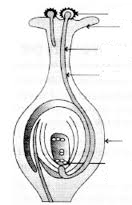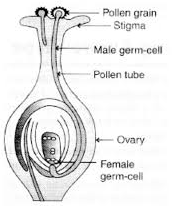How do Organisms Reproduce - Test Papers
CBSE Test Paper-01
Chapter 08 How Do Organisms Reproduce
- How many chromosomes are present in a ovum of human being? (1)
- 29
- 22
- 21
- 23
- Which of the following is an IUCD? (1)
- diaphragm
- copper - T
- tubectomy
- oral pills
- Name the body parts which human beings can regenerate. (1)
- hair liver
- lung, nails
- liver lungs
- hair and nails
- Which of the following is not hermaphrodite? (1)
- bee
- earthworm
- starfish
- leech
- When an organism breaks into a number of parts and each part develop into an individual, it is called- (1)
- Regeneration
- Budding
- Binary fission
- Spore formation
Name the tubules where the sperms are produced. (1)
Which part of the seed form root and shoot? (1)
What is implantation? (1)
Name the various organs of female reproductive system. (1)
Discuss spore formation in fungi. (3)
- Label the following diagram.

- Which process in being shown in the diagram? (3)
- Label the following diagram.
What are the various ways to avoid pregnancy? Elaborate any one method. (3)
What is the function of copper - T? (3)
Write the functions of placenta. (5)
- Give reasons:
- Placenta is extremely essential for foetal development.
- Blocking of vas deferens prevents pregnancy.
- Wind acts as a pollinating agent.
- Use of condoms prevents pregnancy.
- Blocking of Fallopian tubes prevents pregnancy. (5)
CBSE Test Paper-01
Chapter 08 How Do Organisms Reproduce
Answers
- 23
Explanation: Ovum is the female sex cell, or female gamete; the male gamete is the sperm. A gamete, ovum or sperm, contains half the number of chromosomes found in the body cells of the parent, i.e., the gamete is haploid. In human there are total 46 chromosomes, so human ovum has only 23 chromosomes.
- 23
- copper - T
Explanation: IUCD is Intra Uterine Contraceptive Device. Copper T as the name suggests is a T shaped device which is inserted in the female vagina
- copper - T
- hair and nails
Explanation: Hair and nails have a protein called keratin which allows them to grow. The process of growing of nails and hair is known as keratinization.
- hair and nails
- bee
Explanation: Bees show haplodiploidy.
- bee
- Regeneration
Explanation: In this type of reproduction all the parts regenerate into an individual.
- Regeneration
- The seminiferous tubules are the site of the germination, maturation, and transportation of the sperm cells within the male testes.
- 1) Root is formed from radicle.
2) Shoot is formed from plumule - implantation is the attachment of the embryo to inner lining of the uterus.
- Female reproductive system is composed of following organs:
1) A pair of ovaries.
2) A pair of fallopian tubes
3) Uterus
4) Vagina
5) Vulva - Spore formation: The spores in fungi vary in shape. Spores are usually unicellular, thick walled, spherical. The thick walls provide protection till these come in contact with other surface and can begin to grow. Sometimes the spores may be multicellular also. Sometimes the spores are produced endogenously in special sac-like asexual reproductive bodies called sporangia. Spores in such cases are called sporangiospores. Spores on falling on ground or substratum grow new hypha, e.g. Rhizopus, Mucor and Penicillium.


- The diagram show the process of germination of pollen on stigma. Which is necessary for passage of male gametes to ovary. In this the pollen grains develops pollen tube which enters the ovary and releases the 2 male gametes. One of which participate in syngamy and the other in triple fusion.
- Methods to avoid pregnancy are called contraceptive methods. It includes
Surgical methods: Vasectomy refers to surgical method in which vas deferentia in human males are cut and sealed to prevent pregnancy by making seminal fluid devoid of sperms. Tubectomy refers to surgical process in which oviducts in human females are cut and sealed to prevent pregnancy by inhibiting released of egg.- Mechanical barrier that prevent arrival of sperm to the egg, e.g., condom.
- Chemical Drugs or contraceptive pills – Small dosage of female hormones that prevent released of egg.
- Loop or copper-T- physical devices to prevent pregnancy.
- Surgical method- permanent contraception by vasectomy and tubectomy.
- A copper-T is placed safely inside the uterus. It prevents implantation in the uterus.
- The placenta serves primarily as an organ that permits the interchange of materials carried in the blood of mother and foetus. The main functions are:
- Nutrition: Supply of nutrient materials to foetus.
- Respiration: Supply of O2 to foetus and receive CO2 back from it.
- Excretion: Fluid nitrogenous waste products escape through the placenta.
- Barrier: The placenta is barrier like semipermeable membrane.
- Storage: The placenta stores fat, glycogen and iron for the embryo before the formation of liver.
- Hormonal function: The placenta secures extra ovarian hormones estrogen and progesterone in female during pregnancy that serves to maintain foetus.
- Placenta is a temporary organ which is extremely essential for foetal development because it helps in nutrition, respiration, excretion, etc., of the foetus through the maternal supply. Baby connects with placenta via umblical cord.
- Blocking of vas deferens is known as vasectomy which prevents passage of sperms, hence, there is no fertilisation thus it prevents pregnancy.
- Anemophily or wind pollination is a form of pollination where, wind acts as a pollinating agent because it helps in transfer of pollen grains from anther to stigma of a flower. e.g. wheat, rice corn.
- Condoms as physical barrier, which prevent entry of sperms into vagina, hence prevents pregnancy.
- If Fallopian tube is blocked surgically, which is better known by the name tubectomy, sperm and egg do not meet and fuse and fertilisation does not take place.
